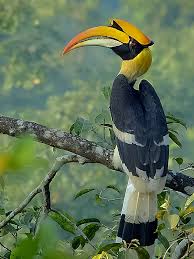Great Hornbill:

The Malamuzhakki Vezhambal (Great Hornbill), Kerala’s State bird, was spotted in the coastal belt of Kakkampara, near Ezhimala in Kannur, an area far from its usual forested habitats.
- The great hornbill, also known as the concave-casqued hornbill, great Indian hornbill, or great pied hornbill, is a large bird and one of the larger members of the hornbill family.
- Scientific Name: Buceros bicornis
- It is found in the Indian subcontinent and Southeast Asia.
- In the subcontinent they are found in a few forest areas in the Western Ghats and in the forests along the Himalayas.
- Great hornbills reside in wet evergreen and deciduous old-growth forests at elevations of 600 to 2000 meters (1968.5 to 6561 feet). For nesting, they prefer trees that tower above the canopy level.
- They are fairly large, ranging from 95 to 120 cm in length and featuring a wingspan of 151 to 178 cm. On average, they weigh 3 kg.
- They are vividly colored and easily recognizable. The body, head, and wings are primarily black; the abdomen and neck are white. The tail is white and is crossed by a subterminal black band.
- A preen gland near the tail secretes tinted oil, which is spread across the feathers by the bird during grooming. This may give the bill, neck, casque, and tail and wing feathers coloration varying from yellow to red.
- The most recognizable feature of hornbills is the casque, which is a hollow structure located on top of the bill. It may be used by males to fight with other males and attract females.
- Like many other hornbills, these birds have prominent eyelashes.
- Males and females are similar except that the irises of males are red while those of females are white, and males have slightly larger bills and casques.
- It is predominantly frugivorous, but is an opportunist and will prey on small mammals, reptiles, and birds.
- Conservation Status: IUCN Red List: Vulnerable.




